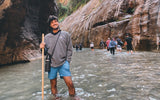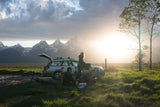Exploring Colorado: A Look Inside Mesa Verde National Park

Contributed by Sophie Goodman
Mesa Verde National Park, a breathtaking expanse of both archaeological and wild landscapes, became Colorado’s first National Park in 1906, and it was also the first in the country established to preserve archaeological history. There are nearly 5,000 archaeological sites—600 of which are cliff dwellings—within the boundaries of the park.
Situated on the Colorado Plateau in the Four Corners region in Southwest Colorado, Mesa Verde was home to the Ancestral Puebloans for approximately 700 years. Archaeologists have called the first generations of Puebloans “Basketmakers” for their skill in the craft. The population flourished as they settled, developed trade routes, and honed plant cultivation, and by 1100 AD (1100-1300 AD, the Classic Period), the Puebloans were utilizing skilled masonry to construct more permanent stone homes and structures.
Today, you can immerse yourself in Ancient Puebloan culture by visiting cliff dwellings (ranging in size from single room structures to village spaces of more than 150 rooms) on guided, Ranger-led tours as well as other historic and natural sites throughout the park, including the Visitors Center and Museum, hiking trails, self-guided tours, and scenic overlooks.
I spoke with Jill Blumenthal, Education Coordinator and Volunteer Program Manager for Mesa Verde National Park and Yucca House National Monument, to learn more about the park, her career in the Park Service, and some suggestions about how visitors can enjoy the park today.

Jill Blumenthal, Education Coordinator and Volunteer Program Manager for Mesa Verde National Park and Yucca House National Monument
Tell me a little bit about Mesa Verde National Park. What can visitors expect to find when they arrive?
Mesa Verde National Park preserves and protects a 700-year history of Ancestral Pueblo people living and farming on this big mesa that we call Mesa Verde. Their story, of course, extends beyond the park boundaries and into the whole region, but Mesa Verde has some of the best-preserved cliff dwellings and also surface dwellings that were built and lived in by Pueblo people starting around 600 AD and continuing up until sometime around 1300 AD.
I didn’t know that Yucca House National Monument is also administered through Mesa Verde. Can you tell me a little bit about Yucca House National Monument?
It’s actually the centennial year for Yucca House this year, which is exciting. Yucca House is also an Ancestral Pueblo structure, and it’s an unexcavated pueblo village. There are many unexcavated pueblos in Mesa Verde National Park as well, but Yucca House is down in the valley closer to the town of Cortez.
We think it dates to the same time period as many of the sites inside the park, but because it’s unexcavated, there’s a lot we don’t know about the site with any certainty. We know that the time period overlaps, and because of its location, we think that Yucca House probably was a significant village. It’s in a central location; I like to say that it’s on the “main road” of what was Ancestral Pueblo travel routes. So, we think that it’s probably a fairly significant site, but because it has not been excavated and has not had a lot of in-depth research done on it, there’s a lot we don’t know.

Entrance to Mesa Verde National Park (Aline Dassel - Pixabay)
Are there ongoing efforts to excavate Yucca House or conduct research?
To the best of my knowledge, there are no plans for excavation. There are thousands of sites in Mesa Verde National Park that have not been excavated, and there are generally no plans to excavate new sites for a number of reasons, including that excavation, by nature, is a destructive endeavor. You can’t ever put it back. In the early days of Mesa Verde, there was a lot of excavation that happened, and in many cases, complete excavation. So, we’ve learned over time that when you completely excavate an archaeological site, people in future generations don’t really have a lot left that they can work with, research-wise. And though we have different techniques and different abilities that we have now that we didn’t have 50 or 100 years ago, complete excavation is still not a viable approach. Furthermore, I think that a lot of Ancestral Puebloan descendants are not in favor of excavation; many of the descendant communities feel that it’s not really appropriate to do that type of work again without a seriously compelling reason.

Park Point (Ken Lund - Pixabay)
Let’s talk about the descendant communities – which tribes are associated with or connected to the Ancient Puebloan people of Mesa Verde and how is that traced?
As of today, there are 26 associated tribes, including 19 Pueblos of New Mexico, the Hopi Tribe in Arizona, the Ysleta del Sur Pueblo in Texas, the Ute Mountain Ute Tribe, Southern Ute tribe, the Northern Ute Tribe, the Navajo Nation, and the Jicarilla Apache Tribe.
The Pueblo people would see themselves as the direct descendants of people who lived in Mesa Verde during Ancestral Pueblo times, and archaeological evidence, oral tradition, and linguistics, and I think there’s even been physical anthropology through limited DNA testing that connects some of the descendant communities to contemporary Pueblos. The Navajo, Ute, and Apache people, I believe, have more of a cultural affiliation. All of the tribes were in the region long before any kind of Anglo-European settlement, so they all have strong cultural and spiritual ties to the area.

Cliff dwellings at Mesa Verde National Park
Are the cliff dwellings and pueblo structures unique to Mesa Verde, or do you find cliff dwellings and similar structures elsewhere in the Four Corners Region?
We find these kinds of structures in other places in the Four Corners region as well; Arizona, New Mexico, Utah, and Colorado all have National Park sites that preserve cliff dwellings. Some of the well-known places might be Canyon de Chelly and Navajo National Monument in Arizona, as well as Bandelier National Monument in New Mexico. It seems as though Pueblo people lived all throughout the Four Corners region, and they built with whatever local materials were available and made sense.
In regards to cliff dwellings, the reason they chose to build there is probably somewhat of an unknown, but we can observe that when you build in a cliff, you have some advantages in that you have some protection from the elements, you have pre-built walls, and here in Mesa Verde, you’re right on top of a water source. The natural cliff alcoves were created by deep springs, and so they basically had indoor running water, if situated in the right spot. Some of the deep springs are still active in the cliffs in Mesa Verde today.

Cliff dwellings at Mesa Verde National Park (roadtrippinwithbob - Pixabay)
I am so interested in this history – it’s just so fascinating to me.
To me, one of the things that makes Mesa Verde so captivating is that in this country we are still really heavily biased toward Anglo-American history. We do tend to neglect the stories of indigenous history; it’s just a piece of American history that, in my view, is still a really under-told piece of our nation’s history.
What can visitors expect to find at Mesa Verde, and what are some ways that they can explore the park?
A lot of the sites require visitors to be on a ticketed, guided tour with a Ranger, and we have some complicated logistics because of the size of the park, so it’s really important that people visit our website and do some pre-planning before arriving.
Cliff Palace, Balcony House, and Long House are the three primary ticketed cliff dwelling tours, and those tickets are sold in person at the Visitors Center, and they’re only sold up to two days in advance of the ticketed tour. We also offer some backcountry tours, and those are available through recreation.gov with advanced reservations. This year, we have tours going to Square Tower House and Oak Tree House, both excavated sites, but the trails in and out of them are less developed and more rugged. Also because of the nature of those sites, they accommodate fewer people, so those tours can only accommodate smaller groups.

Square tower (Mike Goad - Pixabay)
It seems like the best way to experience Mesa Verde is on a two-day visit.
Yes, definitely during the summer season, which is partly because we have two primary districts in the park: There’s the Chapin Mesa area, which is where the museum, Balcony House, and Cliff Palace area all located. And then the other district of the park, which is a bit of a drive, is the Weatherhill Mesa section of the park. And that’s where Long House and Step House are located.
Also, in addition to the cliff dwellings, there are a number of surface sites which are accessible year-round. We have a great driving tour that allows people to more or less do a chronological tour of the whole 700 years of time that people lived here. Additionally, Far View is a pueblo village where people can walk through without a guide and without tickets.
We also have amazing natural landscapes, and this year, it’s been an exceptional year for wildflowers. We have abundant wildlife in the park, including great birding and black bear populations. We also have incredibly scenic hiking trails, so there is a lot to enjoy in addition to the cliff dwellings.
Let’s talk a little bit about your background. How did you learn about the Park Service and how did you come to work at Mesa Verde?
I grew up in the Midwest and grew up traveling with my family to National Parks throughout the country, but many of them were in the West. I really came to love National Parks and from an early age, I came to cherish those experiences with my family. When I was in college, I was studying natural resources and environmental sciences at Purdue University, and I found a position as a Student Conservation Association volunteer. It’s a pretty common program, even now, for people to get their foot in the door in the Park Service. I spent a summer season at Zion National Park with the SCA and I was hooked. I continued to work at Zion on and off as a seasonal ranger for a number of years, and then I was able to get a permanent job at Petrified Forest National Park and continued to work in six or seven other parks. I landed here at Mesa Verde back in 2000.

Mesa Verde National Park (Mike Goad - Pixabay)
The question of Leave No Trace, conservation, and stewardship is perhaps more layered and nuanced when we’re talking about archaeological landscapes. So in the true spirit of learning, I guess my question is then, why is this ethic important to you personally, and then how is it important to the mission of Mesa Verde National Park?
It’s hard to describe, and yes, we tend to use different terminology when we’re talking about archaeological landscapes. The main thing that we spend a lot of time talking about is to leave everything exactly where you found it and to not pick up or move things around. In some more natural places, you do sometimes find stone or pottery pieces on the land, and both from an ethical and research perspective, it’s really important to not pick anything up, to not take anything, and to not move artifacts around. And then when we take people through cliff dwellings, we try to encourage people to move very lightly through the cliff dwellings and not sit or climb on walls. Natural skin oil can leave stains and then people can inadvertently break off pieces of mortar or plaster that have been there for almost 800 years.
The other thing that we’re really strict about is food and drink. When we go into cliff dwellings we don’t allow people to eat or drink anything except for water. Not only is trash that’s left behind unsightly, but the other issue is that trash and crumbs can encourage rodents to come to the cliff dwellings. They often dig holes in the buildings or walls, or they begin to build nests, all of which can be pretty destructive.

Visitors tour the cliff dwellings at Mesa Verde National Park (rspuijbroek - Pixabay)
This has been such an interesting interview – thank you so much. One last question: the big takeaway? What do you want people to leave with after visiting Mesa Verde?
We really try to illustrate to visitors that even though we may be separated by 800 years of time from the people who lived in these cliffs, they were still just families and kids and grandmas and grandpas. They were families that are just like our families. They have spent their days in very different ways than we spend our days today. They may have worn different clothing and they may have lived in a different kind of house, but they had all the same joys and happiness and heartache and many of the same challenges that people do today. And so, we really try to help people make that connection to the past and make that connection to a culture that is really very different from our culture. People are just people. No matter where and no matter when they lived. People are just people.
 Outside the visitor's center at Mesa Verde National Park (mdherren - Pixabay)
Outside the visitor's center at Mesa Verde National Park (mdherren - Pixabay)




